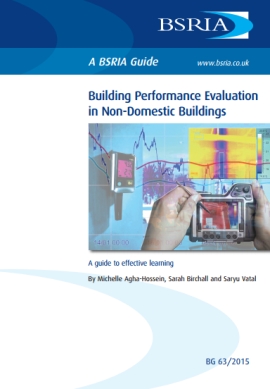Building performance evaluation in non-domestic buildings guide – an introduction to the tests and methods in non-domestic buildings
In September 2015, BSRIA published Building Performance Evaluation in Non-Domestic Buildings Guide – an introduction to the tests and methods in non-domestic buildings.
The guide provides a general introduction to Building Performance Evaluation (BPE), explains why it is important and how it can be carried out. BPE is a form of Post-Occupancy Evaluation (POE) which can be used at any point in a building's life to assess energy performance and occupant comfort and to make comparisons with design targets.
BPE is a key element of the BSRIA soft landings framework intended to help deliver buildings that are effective and efficient and perform as expected. The guide focuses on new, existing and refurbished non-domestic buildings and aims to inform those involved in the design, construction, operation and/or management of a building about its current performance.
The guide discusses some of the tests and methods that can be included when reviewing building performance to provide information about:
- Building fabric.
- Building services and operating strategies.
- Energy use.
- Handover and commissioning processes.
- Occupant satisfaction.
- Occupant comfort conditions.
It suggests that the following factors should be considered when structuring a BPE study:
- Management of building services.
- Nature of occupancy.
- Comfort and controls.
- Indoor air quality.
Catherine England, BSRIA Marketing Officer, said: “Despite genuine intentions to develop efficient buildings, the construction industry is still missing the mark. Recent research from academia and industry has shown that buildings do not always perform in the way that was originally intended. This results in inefficiencies in energy performance, and occupant dissatisfaction. BPE is the process of evaluating how a building performs and can be used on both new and existing buildings in order to address these issues. The publication captures this process.”
NB BSRIA suggest that, “Post-occupancy evaluation (POE) constitutes the activities of the BPE process once the building is occupied and in use, focussing on the operational performance and the occupants of the building. It is important to know to what extent the building maintains its occupants’ satisfaction and perceived comfort. To do this in a systematic and structured way, post-occupancy evaluation (POE) can be employed as a major part of BPE. This would involve collecting feedback (soft data) from the occupants through survey questionnaires, interviews and / or workshops, ideally at least one year after building occupation to cover at least on seasonal cycle.
--BSRIA
[edit] Related articles on Designing Buildings Wiki
- Building performance evaluation.
- Building performance evaluation in domestic buildings.
- Building performance metrics.
- Client commissioning.
- Defects liability period.
- Extended aftercare.
- Handover to client.
- Initial aftercare.
- Lessons learned report.
- Performance in use.
- Post occupancy evaluation.
- Post occupancy evaluation process.
- Post project review.
- Smart meters and building performance evaluation.
- Snagging.
- Soft landings.
- Soft Landings for owners.
Featured articles and news
Government consultations for the summer of 2025
A year of Labour, past and present consultations on the environment, the built environment, training and tax.
CMA competitiveness probe of major housing developers
100 million affordable housing contributions committed with further consultation published.
Homes England supports Greencore Homes
42 new build affordable sustainable homes in Oxfordshire.
Zero carbon social housing: unlocking brownfield potential
Seven ZEDpod strategies for brownfield housing success.
CIOB report; a blueprint for SDGs and the built environment
Pairing the Sustainable Development Goals with projects.
Types, tests, standards and fires relating to external cladding
Brief descriptions with an extensive list of fires for review.
Latest Build UK Building Safety Regime explainer published
Key elements in one short, now updated document.
UKGBC launch the UK Climate Resilience Roadmap
First guidance of its kind on direct climate impacts for the built environment and how it can adapt.
CLC Health, Safety and Wellbeing Strategy 2025
Launched by the Minister for Industry to look at fatalities on site, improving mental health and other issues.
One of the most impressive Victorian architects. Book review.
Common Assessment Standard now with building safety
New CAS update now includes mandatory building safety questions.
RTPI leader to become new CIOB Chief Executive Officer
Dr Victoria Hills MRTPI, FICE to take over after Caroline Gumble’s departure.
Social and affordable housing, a long term plan for delivery
The “Delivering a Decade of Renewal for Social and Affordable Housing” strategy sets out future path.
A change to adoptive architecture
Effects of global weather warming on architectural detailing, material choice and human interaction.
The proposed publicly owned and backed subsidiary of Homes England, to facilitate new homes.
How big is the problem and what can we do to mitigate the effects?
Overheating guidance and tools for building designers
A number of cool guides to help with the heat.
The UK's Modern Industrial Strategy: A 10 year plan
Previous consultation criticism, current key elements and general support with some persisting reservations.
Building Safety Regulator reforms
New roles, new staff and a new fast track service pave the way for a single construction regulator.


























